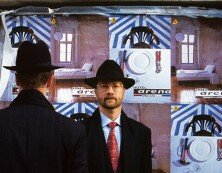Recently I’ve been thinking a lot about the evolution of our industry. Some of today’s firms seem a shadow of their former selves, having forgotten, or at least abandoned, the creation of emotionally impactful design.
I wonder, what exactly has happened to the design consulting profession?
Have we have become so enamored with ‘design thinking’ that we have lost sight of our profession’s original essence – ‘design feeling’? It was Raymond Loewy, the so called “Father of Industrial Design’ who said “It all must start with an inspired, spontaneous idea.” Show me a leading design firm today that has the courage to say such a thing. Again this was Raymond Loewy speaking, the man who, along with Walter Dorwin Teague, reshaped the mass-produced world. Please note the emphasis here; mass produced, these men were commercial behemoths, not ‘one off’ vase designing creatives, but hugely influential designers that shaped American business and American culture.
Which lead me to speculate that the design firm of the future will in fact look like the design firm of the past. Let me explain.
Over the past decade the industry has undergone significant changes – largely very positive as we’ve moved to become more strategic, adopting new practices and processes to satisfy a more demanding and informed business and consumer culture, but recently it seems that in this quest to become “strategic†we have in fact become overly rational, and in some instances have altogether forgotten our emotional roots, aspiring more to McKinsey than to Mackintosh.
Design pioneers relied on an unwavering passion for their craft and unprecedented visionary thinking. They used these skills – the skills of the designer – to create business success for their clients. In the recent past many consultant firms have forsaken the creation of emotionally impactful design in favor of ‘process consulting’; akin to services we’d more likely expect from business consulting firms.
So what caused this transformation, and perhaps more important, what’s next for design?
The shift could easily be a result of firms deliberately turning away from design, potentially due to the current backlash against designers. It’s not rare that we’re accused as perpetrators of ‘fluff’ or more worrisome, creators of ‘landfill’. Add to that the occasional inflated ego and a homogenous fashion sense and we become an easy target to dislike.
It’s also very possible that the ‘Red Threat’ has contributed to the change. With the decreased value of design caused by Asian contract manufacturers essentially giving design away for ‘free’, and thus creating a ‘race to the bottom’ mentality that has resulted in design firms being forced into an upward curve that naturally leads them toward business strategy.
Or maybe consulting firms are simply ‘chasing the ball’. In an industry now dominated by the ‘Innovation’ word, and process oriented ‘design’ consulting, it is indeed hard for a design firm to select a positioning that doesn’t follow this trend. For example, in a recent article published by the UK’s Design Council it was revealed that 2,050 recently published books incorporated the “I’ word. Incorporating ‘Innovation’ into design consulting practices seems to have been lucrative for many design firms, but has also resulted in them shifting to a clear left-brained positioning. Innovation has consumed design.
Without doubt, all of these hypotheses have degrees of truth. But again, it’s what’s next that’s important. So could the future of design lie in the success of our past?
Ironically it could very well be this change that inspires a return to industry roots. Rather than abandoning our founding principles and cultural and emotional approaches for more rational, pseudo scientific ones – we could use our new strategic partnership with business as a vantage point from which to steer the course of design. Rather than compromising our creative soul, we can leverage our understanding and knowledge to appeal to business in a different way.
I feel the next movement in design requires a new form of leadership, one that guides business practice and captures consumer’s imaginations without sacrificing design as the core asset.
I’d like to see this type of leadership in the form of a high impact design firm that is soulful and emotional. A design firm that is creative. A design firm that has a well articulated point of view which they craft through cultural insights, empathy for people, clarity of purpose and sheer inspiration. A design firm that is business friendly, but not business emulating.
The design firm of the future, in that sense, will look like the design firm of the past. Now more than ever, businesses need design, real design.
We need to stop being embarrassed about being designers and embrace the power of creativity. As designers we need to set the agenda based on what we do best – use our intuition, empathetic skills, and clear vision to create powerful business success stories. We need to stop trying to emulate business people. Lets leave McKinsey to consult on business and process improvements, they do it better than we can, but we know (as indeed do they) that they can’t be successful without us. Our place is to create mass produced products that move people.
I’ll leave the final word to Raymond, “It’s a simple exercise; a little logic, a little taste, and the will to cooperate.â€












Discussion (6) Comment